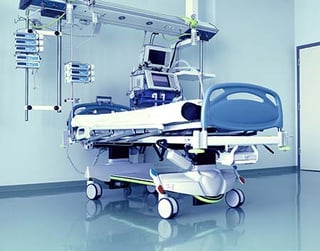
Designing the right product for your customer can be tricky, especially when you’re working with healthcare products like hospital mattresses. You need a healthcare textile that’s going to enhance your product and give you the flexibility and qualities necessary for your design. That’s why using the right healthcare fabric supplier is important.
You need a supplier that’s going to work with your needs. Also, it’s important to remember that part of the design of a hospital mattress includes the layout of the room. You don’t want to create something that’s going to endanger patients because it’s too big for the room. The layout of a hospital room impacts patient safety and incorporates several products that use medical grade fabrics including:
- Bed/Mattress
- Curtains
- Blankets
- Sheets and Covers
- Personal Protective Equipment
The mattress is one of the most important components of the patient or surgical room. It’s where the patient spends most of his/her time. The mattress is typically designed with hospital fabrics that use antimicrobial features and much more. The fabrics are the most important component to consider when engineering a hospital mattress. You don’t want to use something that’s not up to standard or is too bulky or too thin for the hospital setting. Remember, these mattresses get used and abused. That’s why when you design the hospital bed you want to be sure your medical grade fabrics supplier understands the hospital setting. You want your supplier to provide textiles that not only suit your design but can withstand the rigors of the hospital environment.
For instance using something like Sure-Chek® Healthcare Industrial Fabrics makes it simple for your designers and engineers. The textile is the standard in the healthcare fabric industry and are excellent for use in hospital mattress development. Using the right fabric with a quality design and quality non-fabric parts will help you gain the trust and repeat business of your healthcare customers.
Also, remember that it’s important to keep up-to-date about innovations, advances, and new discoveries in the healthcare products industry. For example, did you know that the use of copper rails in hospital beds helps prevent the spread of bacterial infections? You want to be sure that your engineers and your healthcare fabric supplier are staying educated.
It’s also important to note that using the right design with other precautionary measures can help reduce the rate of infections in the hospital setting. This includes using the right medical grade fabrics that incorporate things like antimicrobial features, stain and odor resistance, and more. That’s why finding the right medical mattress fabric supplier is essential; you don’t want to use subpar textiles in your design and risk losing the business you worked so hard to gain.
Now that you know a little more about hospital bed and mattress fabric design, download our eBook "Why Herculite is Uniquely Qualified to Deliver Quality Medical Fabrics" to learn why Herculite has been the top choice of so many healthcare customers for over 50 years.
